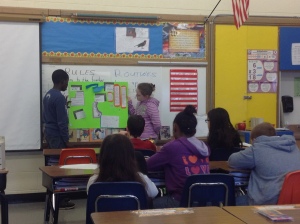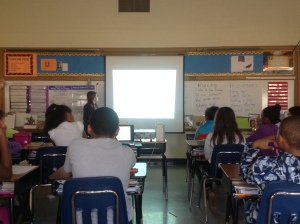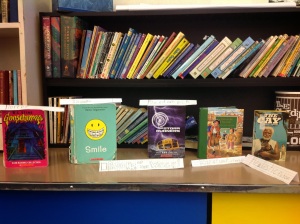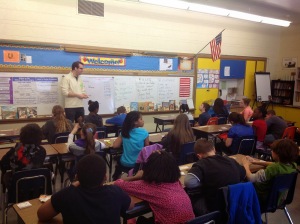Assessmentpalooza
For all the negative press that assessment in school gets, and for all the heated rhetoric used, I, as an educator, cannot avoid this one very simple point: there is simply no way I can teach without assessing. If I don’t know what my students know, how will I know what to teach in the first place? If I don’t know what they have learned, how will I know if they are ready to move on to new topics? If I don’t know how well they can do something, how will I be able to give them appropriately challenging material?
Now, some may argue that all of the negativity about assessing is actually directed toward high-stakes, one-time standardised testing. I can accept that there are probably better ways to collect large-scale data than what has been used for many years, but I also recognise that large-scale data is important for informing education policy. I am excited about the upcoming changes that are on the horizon, as I believe they will begin to provide better options for such assessment.
Because I understand the need for appropriate assessment so that I can better plan my teaching, I know that there will be times during the year when I will have to more assessment than other times. Today was one of those times. It was the last day of the third quarter, which means we have just a couple of months left before the end of school. I worked with my grade-level partner to develop some math and literacy assessments that we wanted to use with both of our classes to give an idea of where our students are at and where we need to go during the last quarter.
My students took the literacy assessment on Tuesday while I was serving as an election judge. They had to read a couple of short passages and answer questions to show comprehension, understanding of main idea, sentence structure, and grammatical elements. I had them take the math assessment today. It covered the wide range of math concepts and skills expected of fourth graders, such as operations, base-ten, fractions, decimals, measurement, data, and geometry. On top of these broad-range assessments, we also finished a unit on division of multi-digit whole numbers by a single-digit divisor, so I gave my students a quiz on this skill in the morning.
The results of these assessments will be used as I plan for the fourth quarter over the coming week. As the quarter gets underway, I will continue to monitor my students’ progress, assess them at appropriate intervals, and find as many ways as possible for them to demonstrate their understanding. Assessments are not the purpose of teaching, nor are they the final word in determining where a student is in their learning, but they are important tools to guide planning and provide snapshots of what the students are doing, both as a whole and as an individual.
While I am planning for the fourth quarter, I hope everyone takes time to enjoy the warm weather during Spring Break! I will certainly be doing more than lesson planning! I hope to get out of doors as often as possible and encourage everyone else to do the same!
Physical Exertion
My fourth grade teaching partner is also the girls’ volleyball coach at Urbana Middle School, so when it comes to physical education, she is much more of an expert than myself. While our classes do not combine for P.E. (fifty students in the gym with just two adults would be a bit much), we often collaborate on plans for what we will have the students work on. So when she told me earlier this week about a plan to have the students work on being able to run a mile, I quickly jumped on board with the idea!
There is a large grassy field in front of our school building that is crisscrossed with sidewalks. It turns out that a particular circuitous path is pretty close to being a quarter-mile. (It isn’t exactly, though. The path we use for the annual walkathon fundraiser, incidentally, is about a third of a mile.) This morning we had P.E. and it was just warm enough to be able to go outside for it so the students could get a feel for what our cardiovascular unit would feel like.
Before going out, though, we talked about safety, especially not pushing oneself too hard the first time doing a specific task. I told the students that I did not want anyone to try to sprint the four laps they were going to do, but to try alternately running, jogging, or walking. We also talked about what could be expected during such physical exertion, such as elevated heart rate and quickened breathing.
Once we got outside, I led the students in some warm-up stretches and then let them start their laps. Some decided to walk all four laps, others alternated their activity. A few boys tried sprinting, despite my caution, and quickly learned that sprinting a mile was not going to work out for them and they ended up walking toward the end. There were quite a few students who complained of breathing quickly and I explained that that is normal after physical exertion, especially running!
After we came in, we took some deep breaths to calm down and settle our heart rates. We also had a short discussion about aerobic exercise, how muscle tissue responds to increased activity, and the common experience of slight pain, or a “stitch” in one’s side after running. While a few students insisted that their hearts were going to explode and they would need to go to the hospital, this didn’t happen for anyone!
We will continue to do this activity after Spring Break. My goal is for the students to start setting goals for their time and learn what they have to do to reach those goals. I will also do some more collaboration with my grade level partner to see what other activities we can do with our classes. And since we will be outside, I am certain that at least some of them will be combined!
I am so glad that the weather is finally warming up with the arrival of spring! After a long, cold, often miserable winter, it is nice to get outside and take advantage of the open space and the fresh air!
A Visit from the UMS Music Program
Following what I hope will be an annual tradition, the entire student body at Wiley today was given a special concert by the Urbana Middle School music program. Featuring the 8th grade ensembles for strings, choir, and band, we were able to listen to a wide variety of music and enjoy a break in the middle of the week as we lead up to the final days before Spring Break.
I love it when the middle school and high school music programs visit. It was always a highlight of the week when the high school in my community growing up visited our school. I still remember the time in grade school when the high school madrigals program visited and gave a silly rendition of The 12 Days of Christmas. When I was in high school, I got to visit the grade schools in the community with the jazz ensembles and the show choirs. (I was in the jazz ensemble my freshman year and then served as their chief sound engineer for the following three; I was also the sound engineer for the show choir.) The jazz ensembles and show choir also went on performance tours together around the community, which was always a wonderful experience!
So I love it when my students now get to have similar experiences. Even if they do not decide to play a musical instrument, join a choir, or get involved in theater, I want them to know that they can. I want my students to consider the wide range of possibilities available to them. I also want to expose them to everything the fine arts have to offer. I know that they know about popular music; they sing it and dance to it every day. I want them to know what else is out there.
My class really enjoyed the performances from the eighth graders they saw today! It was also great that the music directors identified those students who had gone to Wiley in the past. I hope that I will see my own students up there on the stage and on the concert floor in a few short years. I also hope that any students who are currently playing an instrument, singing in a choir, or competing in an athletic competition will let me know. While I can’t always make it to performances or games, I would love to go if I can!
Head Cold
Head colds are awful. They are just bad enough to make you feel miserable, but not quite so bad as to justify staying home to rest. Getting a head cold over the weekend is even worse, though, because you know that even if you were to call in sick, you’d have to go in to work anyway to write up sub plans and make sure everything is ready for the day.
I can usually combat the symptoms of a head cold with regular cold medicine, but late at night I realised that the only medicine I had available at home was some night-time gel caps. I really, really, really hate medicines like that because they seem to leave my head in a fog all day long. But since I needed something to relieve the symptoms so I could at least sleep, I took some before going to bed. I was able to sleep through the night and woke up on time, but it sure was a struggle to make it through the first part of my day!
Even though I felt awful and I was still feeling the side effects of the cold medicine, I was determined to make sure that our day went about as usual! We went to the gym for P.E., several more students shared their colony research reports, we went outside for recess, and we continued to review how to divide multi-digit numbers by a single-digit divisor. And that was just in the morning! The afternoon saw our mix-up math groups also working on division, then my class went to Music. The end of the day was full of reading: another chapter of Bridge to Terabithia, Today’s Topics, and SOAR.
It was a good day, other than the awful head cold! I will not be with my class tomorrow, though, because I will be serving as an Election Judge for Champaign County during the Primary Elections tomorrow. I was hoping to be placed in the precinct that includes Wiley, but my assignment is in Savoy. I am confident that my students will have a fantastic day tomorrow while I am performing my civic duty!
Warm(er) Weather
By most standards, one would be hard-pressed to consider today a day of warm weather. It was about 30 degrees in the morning, with a brisk wind blowing. The temperatures did get up to the 60s this afternoon, which was pretty awesome. According to the calendar, though, we still have a little less than two more weeks of school.
But the weather today was pleasant enough that I was able to do several things I haven’t done since November!
First, I finally got to ride my bike to work again! I live about 5-6 miles away from my building, which is just close enough to be “bike-able” but far enough to make the ride a decent workout. With the constant layer of snow and/or ice we’ve had for the past several months, though, biking has not been an option for me. So today, with the temperatures above freezing and the sun up early (about the only good thing about Daylight Savings Time), I was able to hop on my bike and come to work. It took me about 35 minutes, which is fairly typical, and I was fairly worn out, but it was worth it! I felt energised and ready for the day!
Another thing I got to do today was take my class outside! We went outside last week a few times, but it was still pretty chilly and the students weren’t too excited about being out of doors. Today, though, was our regularly-scheduled day for physical education and I was absolutely going to take advantage of the warm(er) weather! We got some of the balls and headed outside! After doing some stretches and warm-up activities, the students had the option of playing soccer, basketball, kickball, or playing tag in order to soak up the sun’s rays and get some fresh air!
The other thing we did for the first time in what seemed like forever was go outside for a morning recess with other classes! Again, we went outside a few times last week, but we didn’t have a whole lot of time due to testing schedules, and we weren’t able to go out as the same time as the other classes because they were either getting ready for testing or were going to the fine arts classes. So it was quite nice to have multiple classes outside, burning off the energy that has been pent up for so very long!
I know that there is the possibility of cooler weather returning later this week, but I am not going to focus on that. Instead, I am going to be thankful for the warm(er) weather we have today!
Library and Information Science
Way back when I first started attending the University of Illinois, I learned that there was a field of study known as Library and Information Science. I also learned that many of my friends at the university were enrolled in the Graduate School of Library and Information Science, also known as GSLIS (pronounced giz-liss). And thus a whole new world was opened up to me. It had honestly never occurred to me that librarians were trained and certified. I, like many of my students today, thought librarians were just the ladies (I don’t think I had ever consciously known a male librarian) who worked in the library, helped people find books, checked the books out to them, and sent reminders when books were overdue. My friends taught me that librarying (not really a word but how I like to think of it) is so much more than that.
Fast forward to a few months ago when I introduced classroom jobs to my students. Several wanted the role of Book Collectors, knowing that it also meant they were going to be in charge of keeping our classroom library organised. One student, particularly, took a great deal of pride in doing this job. On an afternoon when the students were engaged in preferred activities, I noticed him over by the books, but didn’t pay much attention to what he was actually doing. I figured he was just reshelving for me. Then the students went to their fine arts class and I discovered this display:
I realised that, like me, many of my students’ interactions with librarians were probably limited to our school librarian and the children’s librarians at the Urbana Free Library. I wanted to introduce them to the other things that a librarian or information scientist could do. So I contacted a friend of mine and we worked out an arrangement for a visit. I told him that the students were doing independent research projects, so he came planning on talking about how to find authoritative sources for research, but he ended up doing much more than that.
His visit was today. I introduced Mr. Gough to the class and then they asked him questions about what he did and why he did it. This led to a discussion of the different types of libraries and the different roles of librarians. Then he shared what he does as a data curator. He asked if any of them knew what that was and we saw many hands go up! One student said, “Well, we learned in art that a curator helps organise art in a museum, so I am guessing you do something like that with data?” Wow! A fantastic connection and an accurate definition! He then talked to the students about trying to record information using modern technology but also making it accessible for future researchers. He pointed out that data used to be stored on floppy disks (I absolutely loved it when several students said, “Hey, my dad has one of those!!!”) and how it is hard to access it now because most computers now use more efficient ways to store information.
The brief visit ended with a discussion of using the Internet to find authoritative sources of information and using books which have been edited and/or peer-reviewed. It was a wonderful visit! So many of the students were engaged, asking questions, and even taking notes! I am hoping that they will use this information as they finish their colony research projects. It would be especially great if several of them visited the Urbana Free Library this weekend to seek out books related to their colonies! I am also hoping that this visit, like so many of the others we have had, will inspire at least one student to consider Library and Information Science as a career. There are so many options out there for young people today, but I worry that most of them will never even know about them, so I try to bring in a variety of special guests to broaden their horizons and help them learn more about what they can do!
American Sign Language
Years and years and years ago, there was a family that moved into my community that included a husband and a wife who were both deaf. They also attended the same church as my family, and so we got to know them very well. The husband, Nathan, would eventually serve as my Scoutmaster for a number of years. As I got to know this family, I started picking up bits and pieces of American Sign Language, but I never became particularly fluent, but I did learn the basics like the alphabet, numbers, and how to ask simple questions like who, what, where, and when. I also learned how to ask for the bathroom and, at one point, I could order a meal at a fast food restaurant. (I don’t remember how to do that anymore, though.)
Nathan and Wendy moved away, but I’ve continued to maintain an interest in ASL. One of my older brothers learned it in college and my younger sister learned it and became a certified interpreter. Her husband is deaf, also, so the need to learn sign language has increased. As a classroom teacher, I have tried to incorporate some simple signs in order to improve classroom management and routines. Then a couple of months ago I learned that the district’s sign language interpreter and dead education specialist were going to offer an ASL for Educators course and I quickly signed up. Even though it is just a three-week workshop, I am excited to improve on what I already know and work on because even a little more fluent in signing.
Our first session was yesterday after school got out. While a lot was review of signs I already knew, it was good to refresh my memory and discover that there are some signs I have been using incorrectly. (Oops!) We also learned signs for simple commands, such as sit, stay, stand up, quiet, and look. I decided to start using them with my class today and taught the students what some of the signs meant. (There were several that they could decipher from my expression and what they were doing at the time.) I’m looking forward to using more American Sign Language in my class and helping my students learn to be more effective communicators. I can hardly wait until next week’s class!
Shared Reading
Shared reading is an instructional practice that is typically used in the early primary grades. The teachers uses a Big Book (an enlarged version of a story or other text) to read aloud as the students read along. The class will eventually join in with the reading as they become more familiar with the story. This allows the teacher to model correct reading practices and also helps students build their confidence in their own reading.
But shared reading can be done at the intermediate levels and beyond as well. However, I modify the practice to better accommodate the needs and interests of my students. Instead of a Big Book, I provide each student a copy of the text. I will read aloud and have them read along. This is different from a typical read aloud in that a) each student has a copy of the book and b) I pause frequently to model reading comprehension strategies, such as predicting, asking questions, and making connections.
Most of the shared reading I have done this year has been combined with guided reading as I work with small groups. (This is different from regular guided reading in that regular sessions involve the students reading as I observe. I often combine these practices by reading to the students and then having them read on their own.) But today I decided I wanted to do at least one whole-class shared reading experience, using one of my all-time favourite stories: Bridge to Terabithia by Katherine Paterson.
This is a novel that I read to my class each year. We started today, first watching a book trailer before I gave each student his or her copy. Then I read the first chapter aloud as the class read along with me. I will continue to do the reading aloud, but I will be encouraging students to read on their own, to reread, and even to read ahead. As we finish each chapter, we will stop to talk about what happened and make prediction about what will happen next. I am hoping that my class will enjoy this story as much as they have the other stories I’ve read to them this year!
Calculators
There is only one time in the year that my fourth graders use calculators in class: ISAT Week. The reason for this is actually fairly simple: we don’t need to use them.
Of course, that is a pretty loaded statement, so I’ll elaborate some:
In fourth grade, our focus in mathematics is first on developing operational fluency (being able to perform an operation quickly, accurately, and with understanding). We spend a very large portion of the year on multiplication: mastering the basic facts, understanding the algorithms for multiplying multi-digit numbers, and being able to model with pictures, manipulatives, and words what is going on in a multiplication problem. These are all skills that have to be done without the aid of a calculator. A calculator will give the answer, but that’s about all it is good for. And, as I’ve said before (and will surely say again), having the answer just simply is not enough. So we don’t use calculators in math.
Later on in the year, as we start to work more on identifying the necessary operations in a multi-step word problem, students could use calculators but, quite honestly, none of them have ever asked me, and I have felt no inclination to push it. I am much more interested in them honing their skills as they further develop their operational fluency. And, again, truth be told, the vast majority tell me during ISAT testing that having a calculator doesn’t really help, anyway. That being said, if I am assessing students on their ability to identify the correct operation and not specifically on finding the answer using a specific method, then I will be more than willing to make calculators available.
The other big area of focus for fourth grade is related to understanding fractions. We work on identifying fractions, ordering and comparing, finding equivalent fractions, simplifying fractions, adding and subtracting with like denominators, and multiplying by whole numbers. There are calculators that can help with some of these skills but, much like operational fluency, our fourth graders first need to understand what they are doing when they do it, and a calculator can’t explain that. So there’s just not much use for calculators!
And of course, that doesn’t even take into account other units, such as geometry and measurement. So, like I said, we don’t use calculators because we just don’t need them! Instead, we focus on comprehension, accuracy, fluency, and evaluation (the Math CAFE). Calculators are great tools for checking work and finding a quick answer. I use the calculator on my phone quite often. But I also know how to perform algorithms to find sums, differences, products, and quotients and I can use mental math to assess the reasonableness of the answer so that if I accidentally hit a wrong key, I can tell that the answer is wrong. And that, ultimately, is the biggest goal for me in terms of my students mathematical learning: evaluating an answer to understand if it makes sense or not.
How I Prepared for ISATs
This is my third year at Wiley and therefore my third year administering the Illinois Standards Achievement Tests, also known as ISATs. This is also going to be my final year administering the ISATs, due to the implementation of the Common Core State Standards and the associated Partnership for Assessment of Readiness for College and Careers (PARCC) tests that we will be switching to next year.
In previous years, I have blogged about my students experiences during the four days of ISAT testing. But since I’ve done that twice already and the format hasn’t really changed all that much, I thought I’d focus on what I am doing as a teacher during these tests, instead. (If you are interested in what the students are doing, you can check my archive of ISAT posts here. And yes, I did think we were going to be doing PARCC this year. Sorry to any of my former fourth graders who read my posts a year ago and thought they wouldn’t be doing ISATs this year!)
While my students were taking their Reading I and Mathematics I tests today, I found myself thinking about how I prepared for the exams. Obviously, I am not taking them personally, so I didn’t need to study or prepare for testing. No, I needed to prepare for four days of doing the exact opposite of what I am used to doing as a teacher: sharing, listening, discussing, explaining, responding, guiding, prompting, scaffolding, and answering. I still have to explain, but I am limited by the script that is provided for test administrators. I can prompt, but only in basic terms. I can answer, but often the answer is simply, “I’m sorry, I can’t tell you that. Just read the directions/question again and do your best.” So I had to mentally prepare myself for holding back and letting my students do it entirely on their own.
Even though I am not spending seven hours a day on my feet and talking to students, I still need to eat breakfast and keep up my energy. It may seem weird, but, quite honestly, it is exhausting to monitor students during a test! You have to be ever vigilant in making sure that they are following testing protocols, keep an eye out for students marking answers in the wrong spot or skipping a single line and not realising it until several questions later, and making sure nobody gets out of their seat until the test is totally done. So just like my students, I make sure I get plenty of rest the night before and eat a healthy breakfast. (And a huge thank you to our amazing PTA that provides morning snacks!)
I also prepare what I am going to wear for the week. Yes, I know it sounds weird, but it is one of those things that I started doing three years ago and just keep on doing. The first year, I decided to wear college hoodies all week, in honour of March Madness. I wore shirts with inspirational messages last year to motivate the students to keep their morale up throughout the week. I decided to do the same thing this year. I started this year with my hoodie from the Illinois Teen Institute that I got a few years back that just says “positive” on the front. Simple but important: during testing, I want my students to maintain a positive attitude and I need me to maintain one, too! I’ll be wearing clothing with similar messages all week, so no ties, no cardigans, and no vests. (I know, crazy, right?!)
I’ll also be getting some professional reading done during the week. I have gotten fairly proficient at reading an article or book and keeping an eye on students at the same time. I decided to get to some of the books I got around Christmas time, and am starting Todd Whitaker’s What Great Teachers Do Differently.” If I am able to finish this week (it is a fairly short text, after all), I will try to tackle some other books, too, like Lost at School and Teach Like a Champion.
So that’s how I’ve prepared myself. I don’t know if other teachers do similar things or completely different things, but it works for me!

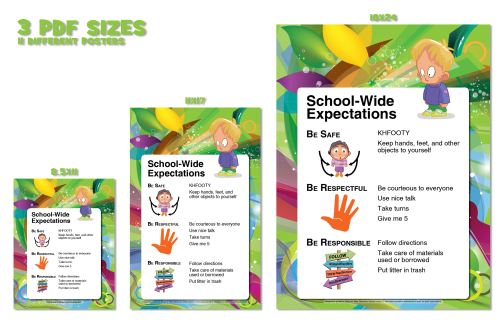
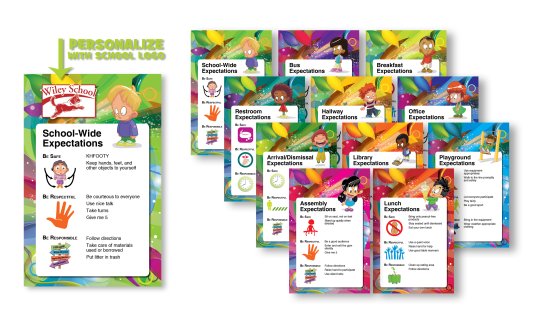
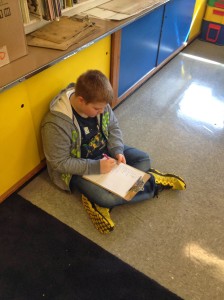
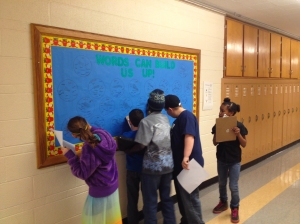
![[UNSET]](https://teachingfourth.files.wordpress.com/2014/03/unset.jpg?w=300&h=201)
